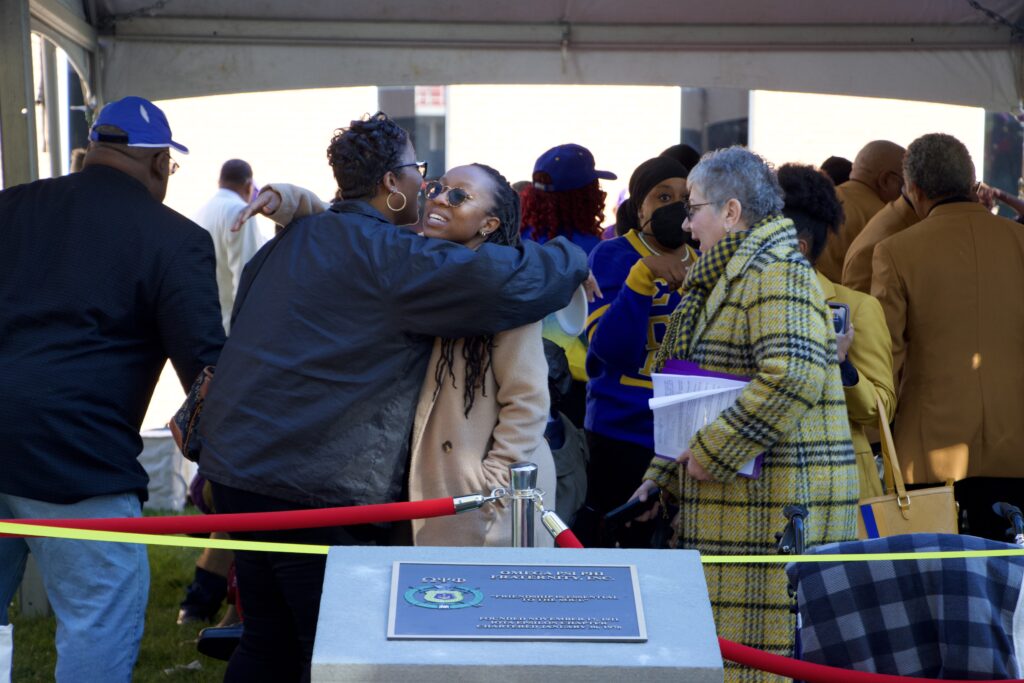
TU honors Black alumni during homecoming with dedications for renamed residence halls, Divine Nine Walkway
By: Caitlyn Freeman, editor in chief
Towson University honored its Black alumni during Saturday’s dedication ceremonies for the National Pan-Hellenic Council tribute walkway and residence halls renamed to honor the University’s first Black graduates, Marvis Barnes and Myra Harris.
The ceremony, held in the courtyard between Barnes Hall and Towson Run Apartments, coincided with the university’s homecoming celebration and saw approximately 325 people in attendance, most TU alumni and the women’s family members.
The University announced the decision to rename the residence halls, originally named after Maryland slave owners Charles Carroll and William Paca, after the 1959 graduates in June.
During the dedication, Harris thanked the university and said she wished her parents were alive to witness the moment.
“I would never have dreamed that this would happen to me,” Harris said.
Echoing Harris, Barnes said the dedication was an honor.
“It has been tremendous,” she said in an interview.
The two women came to the university in 1955, a year after the landmark Brown v. Board of Education of Topeka U.S. Supreme Court decision in 1954 that deemed segregated schools unconstitutional. At the time, the university, then the State Teachers College at Towson, was an all-white institution.
The women went on to have careers in education.
At the ceremony, Schatzel said the women’s decision to attend the university despite the lack of diversity had a lasting impact on herself and the Black TU students who followed in their footsteps.
“They didn’t ask,” Schatzel said. “They didn’t volunteer. They didn’t know that they would create historic change. They were simply courageous.”
Chris Barnes, son of Marvis, spoke on his mother’s behalf during the ceremony. Echoing Schatzel, He said his mother’s humility for her accomplishment is prevalent, especially after deciding to attend the all-white school during the summer of 1955, the same summer as the Murder of Emmett Till.
Till, a Black 14-year-old from Chicago, was lynched in Mississippi by two white men after he was wrongfully accused of making flirtatious comments at a white woman.
“Brown vs. Board of Education was 1954, Emmett Till was 1955,” Chris Barnes said. “This was the same fall at the climate in our country where these two women decided that they were going to go […] and they want to integrate what we knew was an all-white institution.”
While the university struggled to integrate in the years following the Brown ruling, 59% of students in the fall 2022 incoming class identify as a racial or ethnic minority.
Gloria Scott, a 1962 TU graduate, said she lived in Richmond Hall with Harris. She said she was surprised about the university being on track to become a majority-minority institution.
Scott said the renaming of the buildings is “wonderful.”
Students began demanding the renaming of the buildings in 2016, The Towerlight reported. In 2020, President Kim Schatzel created a committee to review the names per the TU Policy on naming facilities.
In August 2021, the residence halls were stripped of their names and temporarily referred to as West Village 1 and 2 until the announcement in June.
In addition to the buildings, the Barnes-Harris Scholarship Endowment, created in 1993 by Granting Opportunity for Learning and Development Associates members, provides funds for incoming first-year students showing financial need. Monica Taylor, G.O.L.D Associates president, said this year, over $100,000 was raised for the endowment.
Saturday also saw the ribbon cutting of a new walkway in Chapman Quadrangle honoring the TU chapters of the nine historically Black fraternities and sororities within the National Pan-Hellenic Council.
The event was attended by nearly 600 alumni and current TU Greek life members, many of which donning Greek regalia. The walkway honors each chapter with a brick monument and a plaque listing the charter members of each chapter.
The organizations, collectively known as the Divine Nine, fundraised over $100,000 from 581 donors for the walkway. The walkway was built using Black-owned construction companies, Brian DeFilippis, vice president for University Advancement, told the crowd.
As a member of the Alpha Kappa Alpha Sorority, Patricia Bradley, TU’s vice president of the Office of Institutional and Instructional Equity, said the walkway represents the university’s commitment to providing students with a sense of belonging.
“I can only imagine what life must have been like for both of Mrs. Barnes and Mrs. Harris and the original founders of the NPHC organizations that represent us today on this campus,” Bradley told attendees. “The students who didn’t have the protection and safe place for their sororities and fraternities. I can only imagine.”
The walkway, located next to the Media Center, is also home to a bust of Julius Chapman, TU’s first dean of minority affairs. Chapman, who attended Saturday’s dedications, joined the university in 1969.
Chapman, a mentor for the school’s Black population, created the Black Cultural Center in 1970 and helped establish the Black Student Union. He said the university’s advancements since his tenure had left him speechless.
“I have to pinch myself every now and again,” Chapman said in an interview.
Representatives from all Divine Nine organizations helped Schatzel and Chapman cut the ribbon to the walkway. After, with linked arms, Chapman and Schatzel walked down the path together as attendees cheered.
Paul-Sean Gray, a member of the Iota Epsilon chapter Omega Psi Phi fraternity and member of the G.O.L.D Associates, said the walkway solidifies TU’s dedication to the Divine Nine.
“By erecting these monuments, Towson has shown its appreciation for D-Nine culture,” Gray said during the ceremony. “To all its members, past and future students, and to the world, is an outward symbol of the university’s recognition that the D-Nine community has been a vital and valuable component of Towson and its growth. Finally, we had a permanent presence on our campus.”



















